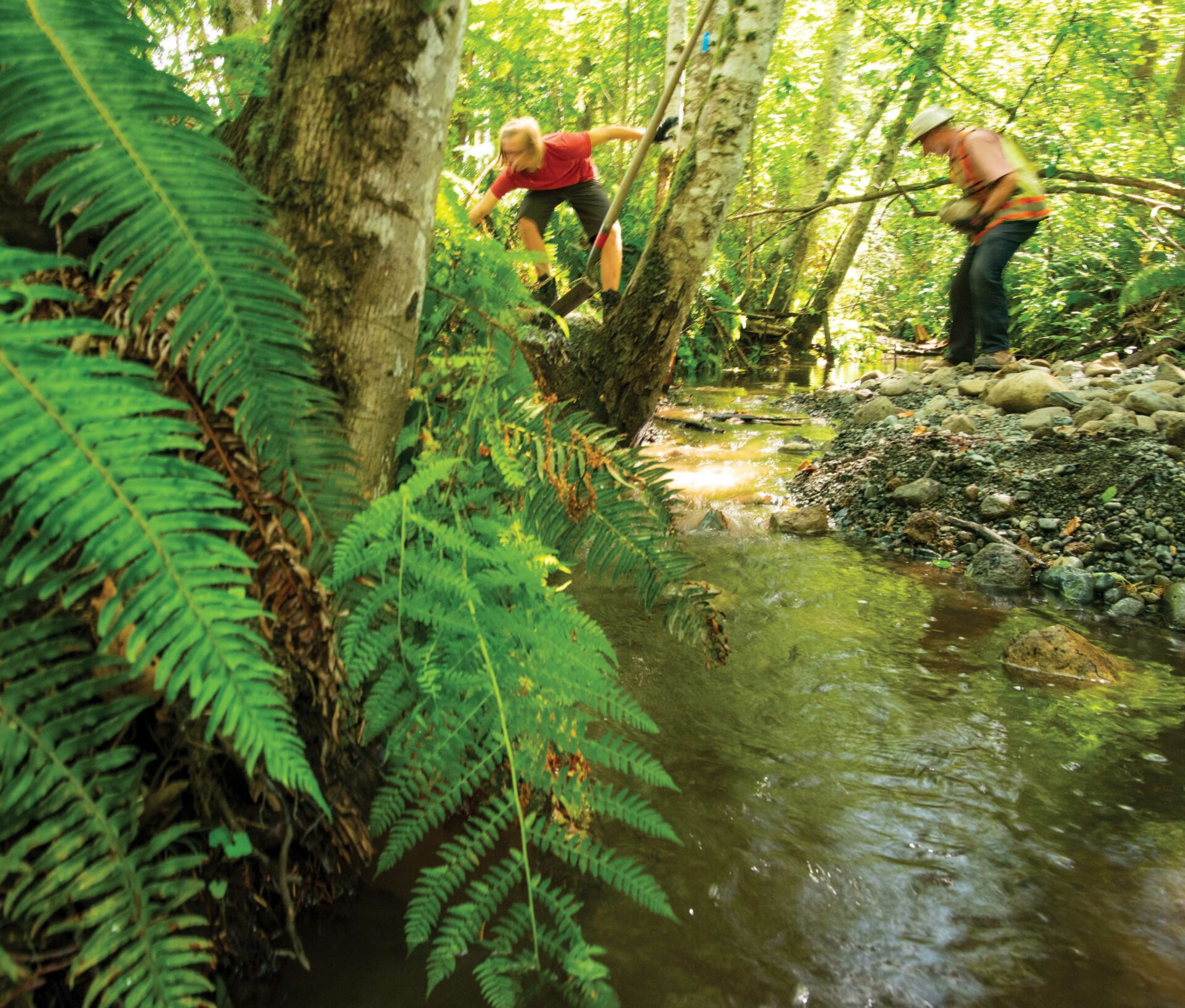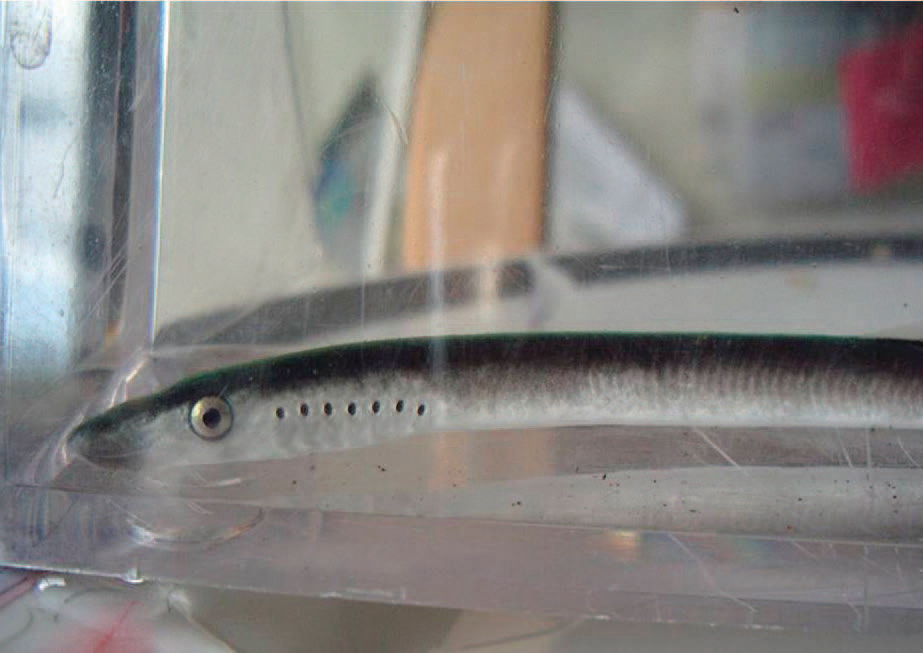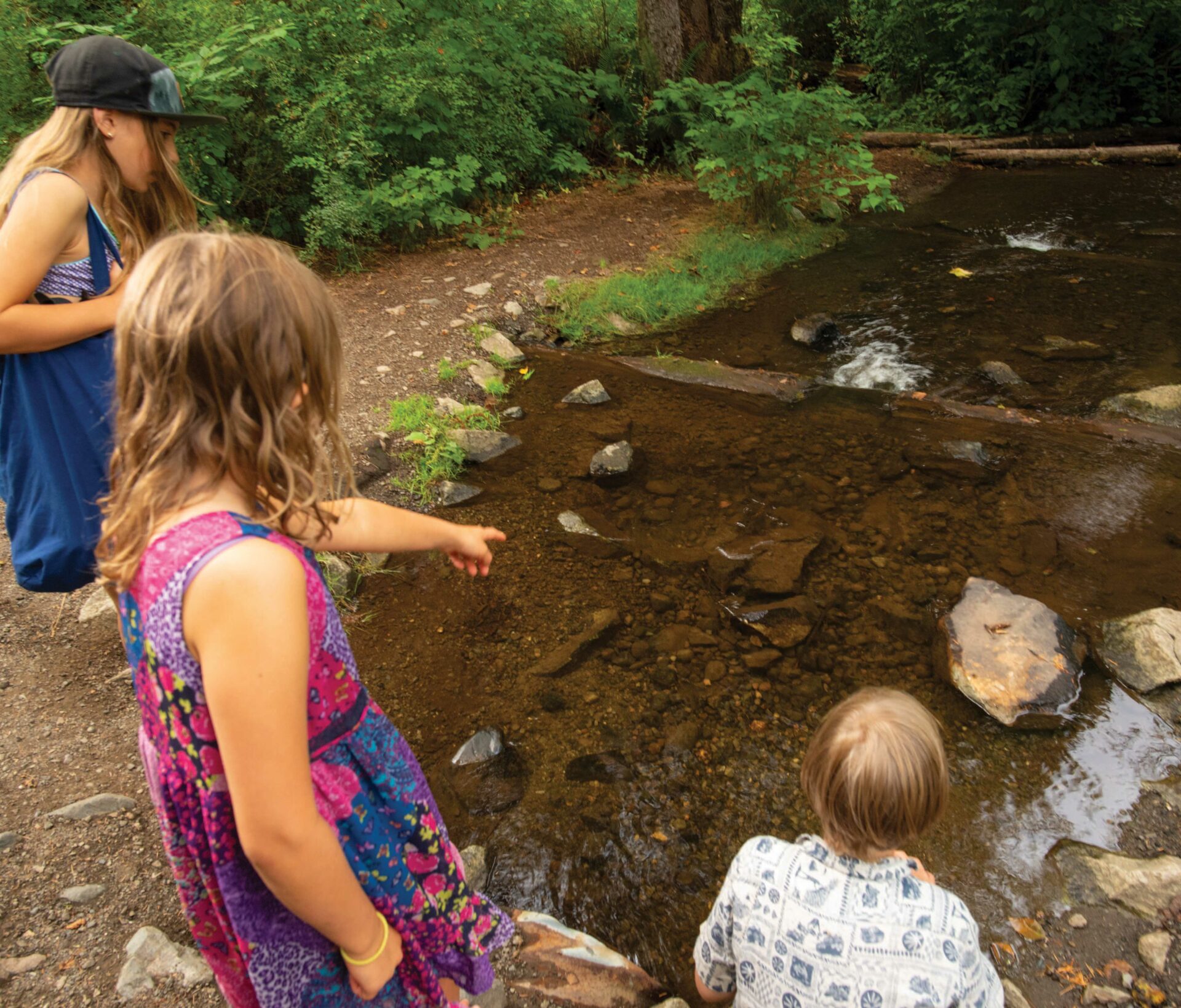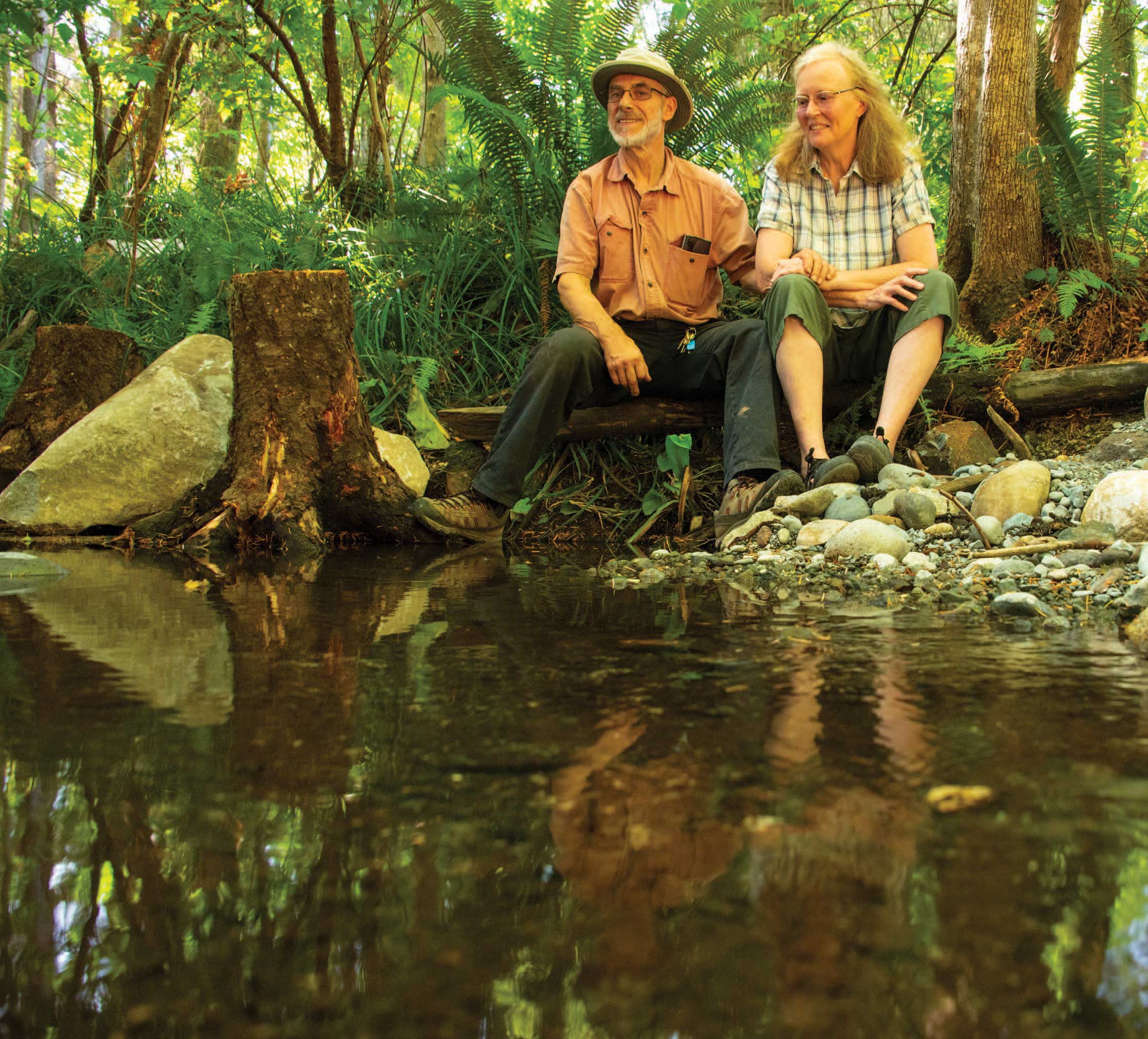On a hot July afternoon, I followed Jim Palmer and Jan Gemmell along an overgrown logging road in the forested headwaters of Morrison Creek. The shade of the forest was welcome respite from a searing summer scorcher—for humans and fish.
For the past 20 years, this couple has been a driving force behind the Morrison Creek Streamkeepers, one of dozens of volunteer groups in British Columbia united by a goal—to do what they can to give salmon and other fish species a fighting chance for survival. For the most part, it’s peaceful and quiet in these woods, frequented mostly by a few dog walkers, hikers and bikers in the know. Except for a few stubborn stands of primal western redcedar, it’s forested mostly with mature second-growth fir, cedar and hemlock. And if you know where to look, you can find beneath the moss and ferns the crumbling concrete and brick footings of a 1920s sawmill that burned to the ground long ago. It’s ghostly, a relic from an era when big trees were felled and milled on location. After 10 minutes of walking, Palmer and Gemmell veered off the old road, down a small embankment tangled in ninebark and salmonberry bushes, to where a trickle of a tributary emerges from a culvert. Coho fry, the length of my pinky, darted in clear pools—the same waters where their life’s journey began a few months earlier.

“It’s all about the headwaters,” Palmer said, as he kneeled and watched the flash and flicker of fish.
It’s mesmerizing, even miraculous. Given the perilous state of Pacific salmon, Morrison Creek stands out in the Comox Valley as a small but welcome success story. It’s symbolic of how important volunteer stewardship coupled with natural stream conditions is for the future of a species, one that is so enmeshed with the provincial identity that it’s hard to fathom our rivers without them. But, these days, it’s a real possibility.
This tract of land in the upper reaches of the Morrison Creek watershed, bound by logging roads, highways and city limits, is infinitely important to the stream’s health—sacred, you might even say. That’s why when Palmer, Gemmell and their fellow Streamkeepers captained the purchase of 22 hectares to protect the source of this small but mighty stream in 2019, it was probably their most significant act of conservation.
Morrison Creek is more or less a suburban stream. It meanders for less than 20 kilometres from its source on the outskirts of Courtenay, through backyards and neighbourhoods, and the grounds of Ecole Puntledge Park, to its confluence with the Puntledge River, steps from where Palmer and Gemmell have lived for more than 20 years. Morrison is one of thousands of streams that have contributed over millennia to the genetic diversity of salmon. It’s obscure in some ways, but in other ways it’s infinitely important and special for salmon survival. And as Palmer said, the headwaters are its secret sauce.

The creek rises in a spider’s web of tiny spring-fed trickles that flow from an escarpment just northwest of Comox Lake. While many streams are subject to seasonal variations in flow and temperature, Morrison gets a steady and consistent supply of cool, spring-fed water. Fish love it. Consequently, all salmon species except sockeye return to spawn in its gravel beds, along with cutthroat and rainbow trout and dolly varden. But the stream has another, much more curious inhabitant—the Morrison Creek lamprey. It’s a subspecies of western brook lamprey, an aquatic invertebrate widely found in temperate rivers and seas. They grow to be about as long as an adult human’s index finger, and scientists believe lampreys have been around since the Paleozoic Era, roughly 300 million years ago. Given that the Morrison Creek lamprey is found only in its namesake creek, the Committee on the Status of Endangered Wildlife in Canada (COSEWIC) lists the species as “endangered.” Lampreys are as shy as they are ecologically bizarre. They spawn just once in a lifetime, depositing eggs in streambed gravel much as salmon do. After hatching, the young quickly burrow into soft sediments where they live for between five and seven years, before emerging as swimming adults. They don’t exactly make themselves easy to spot. Nevertheless, we scoured the tributary for signs of this strange little Morrison Creek creature—without success.
“We know they’re here, it’s just impossible to know how many,” Palmer said.
Salmon are a different story, much easier to sample and count in streams. And coastwide, the numbers aren’t good. Once abundant, they have been driven to the edge by logging, over-fishing, and disease and parasites originating from open-net pen salmon farming. Fisheries and Oceans Canada says some stocks have collapsed more than 80 percent, while others have been extirpated entirely. It’s the reason the federal agency took the drastic measure of suspending more than 60 percent of the 2021 commercial fishing season, in addition to curtailing sport fishing opportunities.
And now climate change is starting to feel like a coffin nail for wild salmon. They are a cold-water species, thriving at temperatures in the mid-teens but struggling when it’s over 20ºC. Warmer water holds less dissolved oxygen, making it harder for them to breathe. It accelerates their metabolism, which in turn causes them to require even more oxygen and food. At the same time, they burn additional calories searching for cool water. In other words, warm water stresses salmon to the danger point.
Last July, when temperature records on the West Coast were smashed during an unprecedented heat wave, so were water temperature records. In the nearby Tsolum River, which suffers from low flows in the summer and fall, temperatures reached 27ºC. During the heat wave, Courtenay fish biologist Warren Fleenor said his phone was ringing with reports of fish found floating dead in shallow streams and lakes.
“I was super stressed,” said Fleenor.
Over the years he has managed numerous stream rehab projects in the Morrison watershed.

“It’s an amazing stream,” he said. The increasing intensity of hot summer droughts has put an exclamation mark on Morrison Creek’s unique qualities; its consistent flow of cool water, clean gravel and clear pools, not to mention a volunteer group that won’t take “no” for an answer.
Over the years the Morrison Streamkeepers have devoted countless hours restoring riparian habitat, counting fish and mapping tributaries. To say Palmer and Gemmell know it like their own backyard is not an exaggeration. But still, it could all be for nothing if it weren’t for Morrison Creek’s life-giving source.
Headwater protection was key to the creek’s vitality but also challenging given that it is all private land, owned either by individuals or private land loggers. Strangely, it was almost by accident that the stewards learned that piece of it was being put on the market.
“One of the residents up here saw a ‘For Sale’ sign and told us about it,” Palmer said, as we walked and stopped occasionally to pick plump salmonberries. The former owners, the Linton family, made their money building roads and logging. It could have gone so many other ways for the headwaters. At one time the Linton patriarch pondered developing a golf course in the headwaters—had that plan come to fruition, it could have meant the end to Morrison Creek salmon, not to mention lampreys. When that dream fell flat, he logged and replanted a portion of it instead. When his heirs decided to sell, it presented a once in a lifetime opportunity for Morrison Creek conservation. Acting quickly was key. But volunteer streamkeeper groups don’t have deep pockets, or really any pockets to speak of. It’s all about bootstrapping, doing projects on a shoestring and grant writing. This time their fundraising efforts were aided by the fact that the Comox Valley Land Trust had already identified the headwaters as high priority for protection.
Things moved quickly. In less than a year, the group had cobbled together individual donations, as well as funding from a who’s who of government and non-government funding agencies, including Pacific Salmon Foundation, Habitat Conservation Trust Fund, Habitat Stewardship Program, Courtenay Fish and Game and the Sitka Foundation, the private family foundation of Vancouver mining financier Ross Beaty and his wife Trisha.
An offer was made and accepted. It cost $820,000 and it was worth every penny, Palmer told me.
“We always knew how important the headwaters are, but I think climate change has really made the case stronger. This protects the main stem of the headwaters, and it takes in wetlands and a big beaver pond.”
Both the Comox Valley Land Trust (CVLT) and the Comox Valley Regional District are on the land title. The property is protected by a legal covenant preventing future development no matter who sits around the regional district board table.
“Morrison is one of the last large core areas of intact habitat left in the eastern Comox Valley. It includes species at risk found nowhere else on Earth. It has a climate-proof hydrologic system that is part of the reason why it is the most important wild salmon spawning stream of its size anywhere on the east side of Vancouver Island,” said Tim Ennis, CVLT’s executive director. “And generally it’s not visited by people so it remains an important refugium for wildlife.”
We walked for another 15 minutes, then branched again onto a faint trail padded into the forest floor. A minute later, the forest opened onto a sunlit wetland. It’s another important feature of the newly protected headwaters—wetlands are nature’s water storage and filtration system. Palmer and Gemmell call this spot, prosaically, the Big Dam Pond. It is also a fount of biodiversity. Gemmell, an avid birder, stood on a moss-covered log, her attention suddenly drawn somewhere else. A shrill call, like someone drawing air through a tin whistle, filled the forest.
“Do you hear that?” she said. “It’s a baby barred owl.”

For this couple, their volunteer devotion to Morrison Creek has been about much more than simply protecting fish. That’s the thing about salmon habitat; when you protect it, you also preserve a living ecosystem that’s home to a myriad of other species—deer, cougar, pine marten, owl, west-ern toad and so many more organisms that contribute to the whole in fascinating ways. Streams act as natural wildlife corridors. Call it a tangential, but no less important outcome.
More than two decades since first plunging into the role of Streamkeepers, Palmer and Gemmell still get ex-cited about Morrison Creek. With every walk, they learn more about what makes the watershed tick. Counting fish is important, but underlying their efforts is the knowledge that a healthy salmon stream nourishes an entire matrix of flora and fauna, and in some ways nourishes the soul of BC. Later in our work, Palmer stopped again by a water-filled ditch, another one of the many small tributaries that gather to form Morrison Creek. Coho fry flickered in the shadows. Salmon are amazingly resilient; despite the vagaries of human interference, given half a chance they will find a gravel bed in which to spawn.


